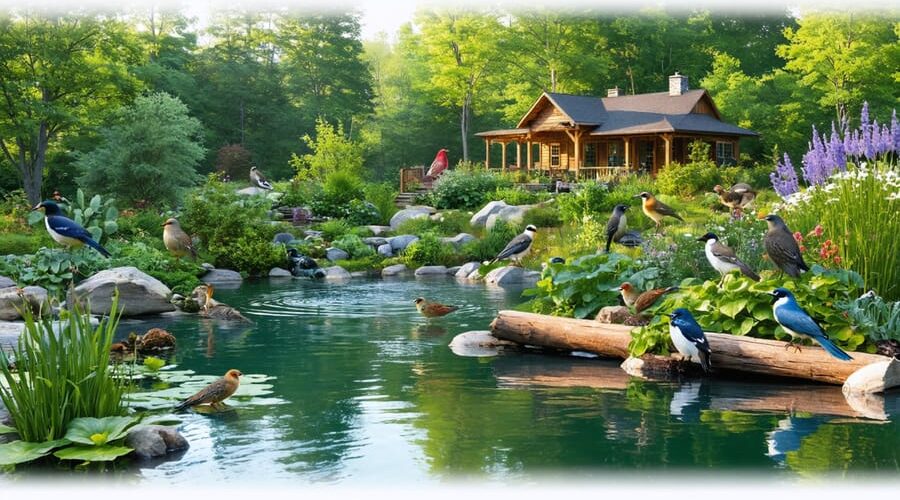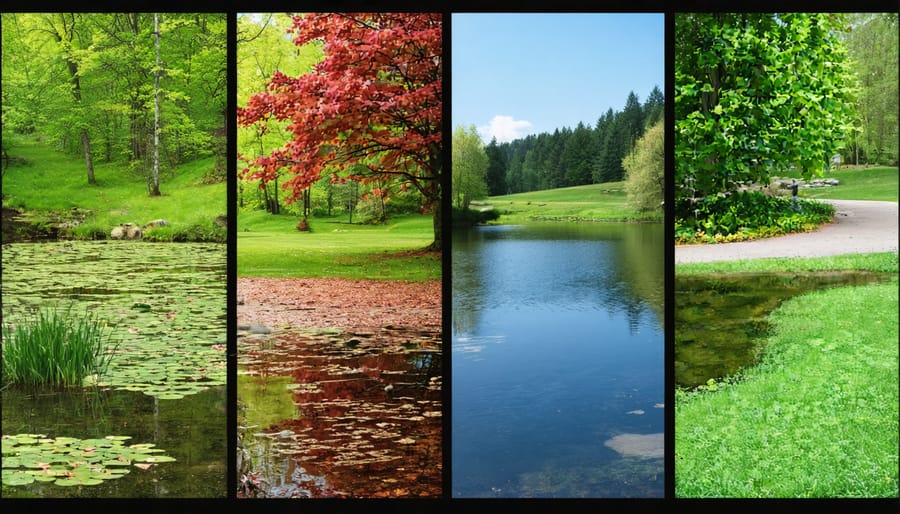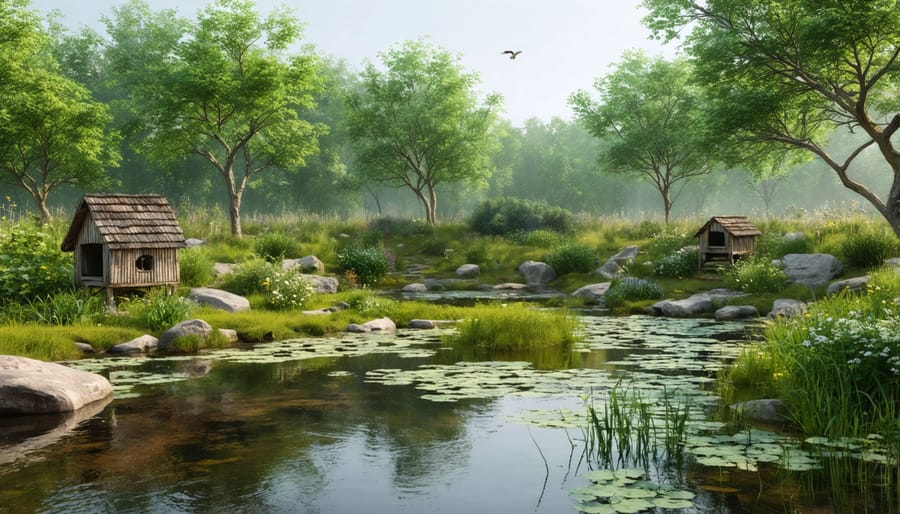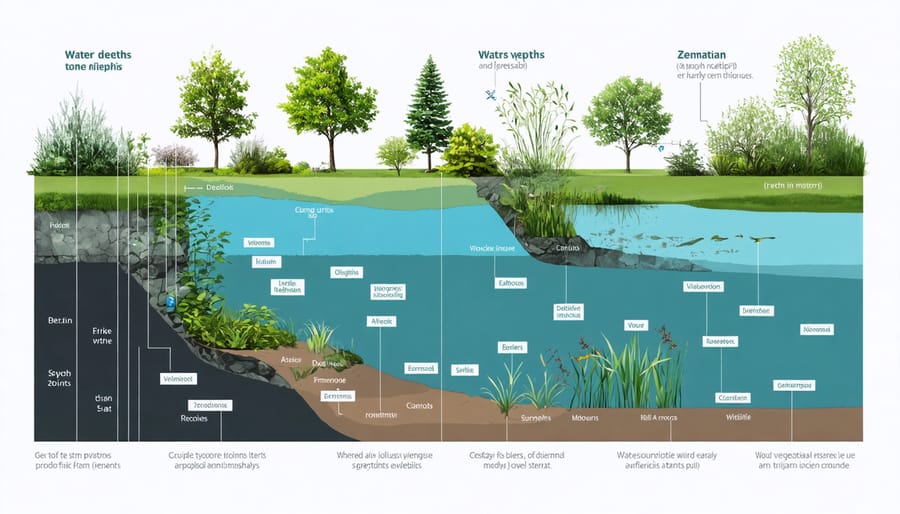
Transform Your Pond into a Year-Round Wildlife Haven (That Actually Works)
Transform your backyard into a thriving wildlife sanctuary by creating interconnected habitat zones that support diverse species throughout their life cycles. Native plants, varying water depths, and strategically placed shelter form the foundation of successful wildlife management, working together to provide food, cover, and breeding areas for local fauna.
Managing wildlife habitats requires a delicate balance between human intervention and natural processes. Strategic placement of fallen logs, brush piles, and native vegetation creates essential corridors for wildlife movement, while maintaining clean water sources and establishing buffer zones protects both wildlife and their environment. These elements work in harmony to support everything from beneficial insects to larger mammals.
Seasonal monitoring and adaptive management practices ensure your habitat remains resilient and productive year-round. Regular assessment of plant health, water quality, and wildlife activity helps identify areas needing adjustment, while implementing conservation practices like reduced mowing and chemical-free maintenance supports long-term ecosystem stability. This holistic approach not only benefits local wildlife but also creates a sustainable, self-maintaining environment that enriches your property’s biodiversity and natural beauty.

Creating a Four-Season Wildlife Support System
Spring: Supporting Breeding and Nesting
Spring is nature’s busiest season for wildlife activity, and your habitat management efforts during this time can make a significant difference. As temperatures warm up, focus on creating safe, nurturing spaces for breeding pairs and their upcoming offspring.
Start by maintaining or installing nesting boxes at varying heights around your property. Clean out old boxes and ensure they’re securely mounted before breeding season begins. For ground-nesting birds, create protective cover using native grasses and low-growing shrubs. Leave some areas of longer grass unmowed to provide natural nesting materials and shelter.
Water features are particularly important during spring. Keep pond edges shallow and gently sloped to provide safe access for amphibians laying eggs. Install partially submerged logs or rocks near the water’s edge as basking spots for turtles and places for birds to drink and bathe safely.
Consider planting early-blooming native flowers to support pollinators emerging from winter hibernation. Pussy willows, spring beauty, and wild columbine are excellent choices that provide essential early-season nectar. Create brush piles using fallen branches and leaves, which offer shelter for small mammals and nesting materials for birds.
Minimize disturbances during this sensitive time. Delay major landscape maintenance until after the primary nesting season, typically late July. If you must work in your garden, carefully check for nests before pruning or clearing vegetation. Keep cats indoors and consider installing predator guards on nesting boxes.
Remember to maintain a continuous food supply through supplemental feeding, especially during the “spring gap” when natural food sources may be scarce but energy demands are high for breeding animals.
Summer: Providing Shelter and Food Sources
Summer brings unique challenges for wildlife, making it crucial to provide adequate shelter and food sources in your garden or pond area. Creating shaded retreats helps animals escape the intense heat, while strategically placed water features offer essential hydration spots.
Consider installing a variety of shelter options at different heights. Ground-level brush piles provide cover for small mammals and reptiles, while dense shrubs and trees offer nesting sites and cooling shade for birds. Native climbing vines can create natural screens that double as food sources when they fruit.
Water features are particularly important during hot months. Beyond your main pond, consider adding shallow bird baths or small water dishes in shaded areas. Remember to maintain clean, fresh water and create gentle slopes or stepping stones to help smaller creatures safely access the water.
For food sources, focus on plants that produce summer berries and seeds. Flowering plants like coneflowers, black-eyed susans, and native wildflowers attract pollinators and provide seeds for birds. Consider planting fruit-bearing shrubs like elderberry or blackberry, which offer both food and shelter.
Create butterfly gardens with nectar-rich flowers and host plants for caterpillars. Maintain areas of long grass for insects, which in turn provide food for birds and other wildlife. Leave some open, sunny spots for basking reptiles, but ensure they have nearby cover for quick retreat.
Don’t forget to maintain some messy areas in your garden – dead wood, leaf litter, and unmowed sections provide valuable habitat for countless beneficial insects and small creatures that form the foundation of a healthy ecosystem.
Fall: Preparing for Migration and Winter
As autumn’s crisp air signals the approaching migration season, it’s crucial to implement effective autumn preparation strategies for your wildlife habitat. Start by maintaining dense vegetation around your pond, which provides essential cover for migrating birds and local wildlife preparing for winter.
Add native berry-producing shrubs and late-blooming flowers near your pond to offer natural food sources for passing wildlife. Leave seed heads on plants intact, as they serve as valuable food sources throughout the colder months. Consider installing a heated birdbath or maintaining an ice-free section of your pond to provide drinking water when natural sources freeze.
Create brush piles using fallen branches and leaves to offer shelter for small mammals and birds. These natural hideaways also provide excellent spots for beneficial insects to overwinter. Don’t be too quick to remove dead plant material – it offers crucial protection for hibernating creatures.
For amphibians and reptiles, ensure there are deep enough zones in your pond (at least 2-3 feet) where they can safely overwinter below the freeze line. Add submerged logs or rocks to create hibernation spots. Consider installing a small pond aerator to maintain oxygen levels under winter ice.
Remember to gradually reduce feeding as temperatures drop, allowing wildlife to transition naturally to their winter patterns. Keep some areas of longer grass and fallen leaves untouched – these provide natural insulation and foraging opportunities for winter-active species. By preparing thoughtfully in fall, you’ll create a sanctuary that supports wildlife through the challenging winter months ahead.
Winter: Maintaining Critical Resources
As temperatures drop, maintaining critical resources for wildlife becomes essential for pond ecosystem survival. To winter-proof your pond and support local wildlife, focus on creating ice-free zones and ensuring consistent food access.
Keep a section of your pond unfrozen by installing a floating de-icer or maintaining pump circulation. This allows wildlife to access drinking water and provides vital oxygen exchange for fish and other aquatic creatures. Position your de-icer away from deep areas where fish typically overwinter to avoid disturbing their natural hibernation patterns.
Food availability becomes crucial during winter months. While you shouldn’t overfeed fish during this time, maintaining bird feeders near your pond can support local and migratory birds. Position feeders about 10-15 feet from the water’s edge to prevent excess feed from falling into the pond while keeping food accessible to both water and land birds.
Create windbreaks using evergreen shrubs or temporary barriers to protect wildlife from harsh winter elements. These structures also help prevent excessive ice formation and maintain slightly warmer micro-climates around your pond. Leave fallen leaves and branches in designated areas to provide natural shelter for small animals and insects.
Monitor snow accumulation around your pond’s edges. While some snow cover can insulate the pond, too much can block light penetration and affect underwater plant life. Gently clear heavy snow from at least a portion of the pond’s surface to maintain some natural light penetration while being careful not to disturb any wildlife seeking shelter beneath.

Essential Plants for Wildlife Support
Creating a wildlife-friendly habitat starts with selecting the right plants that provide food and shelter throughout different seasons. Understanding aquatic plants year-round care is essential for maintaining a thriving ecosystem.
Native plants should form the foundation of your wildlife garden. Trees like oak, maple, and birch provide nesting sites for birds and support numerous insect species that serve as food for wildlife. Shrubs such as elderberry, viburnum, and holly offer both shelter and berries that sustain birds during winter months.
For ground cover, consider plants like Virginia creeper and wild strawberry, which provide excellent coverage for small animals while producing fruits. Native wildflowers, including coneflowers, black-eyed susans, and milkweed, are crucial for pollinators and create seasonal food sources.
Around your pond, incorporate marginal plants like cattails and rushes that offer cover for amphibians and nesting materials for birds. Water lilies and floating plants provide shade for fish and landing spots for dragonflies, while submerged plants offer spawning areas and shelter for aquatic creatures.
Layer your plantings to create different heights and habitats. Include:
– Tall grasses for winter shelter
– Berry-producing shrubs for fall and winter food
– Spring-blooming flowers for early pollinators
– Summer-flowering plants for continuous nectar sources
Remember to include plants that produce seeds and fruits at different times, ensuring a year-round food supply for local wildlife. Native species are always the best choice as they’re adapted to local conditions and naturally support indigenous wildlife populations.

Managing Water Features for Wildlife
Managing water features for wildlife requires a thoughtful balance of maintenance and natural elements. Start by ensuring your pond has varying depths, with shallow edges for small creatures and deeper sections for fish and amphibians. Create gently sloping banks to help animals easily enter and exit the water.
Keep water clean and healthy by installing a reliable filtration system, but avoid over-cleaning, as some natural debris provides essential nutrients and hiding spots for wildlife. Add native aquatic plants around the edges and floating varieties to provide shelter and breeding areas for insects and amphibians.
Consider installing a small fountain or waterfall to maintain oxygen levels and create movement that attracts birds and beneficial insects. During dry periods, maintain consistent water levels to support resident wildlife. In winter, keep a small area free from ice to allow animals to drink and aquatic creatures to breathe.
Remember to avoid using harsh chemicals for maintenance, as these can harm wildlife. Instead, opt for natural solutions like beneficial bacteria and proper plant balance to maintain water quality.
Creating a wildlife-friendly pond habitat is a rewarding journey that enriches both your garden and local ecosystem. By following seasonal maintenance schedules, choosing appropriate plants, and maintaining proper water quality, you can develop a thriving environment that attracts diverse wildlife year-round. Remember that every small effort counts – from adding native plants to creating shallow areas for amphibians. Start with simple steps and gradually expand your habitat features as you become more comfortable. Your pond can become a vital sanctuary for local wildlife while providing you with endless enjoyment and learning opportunities. Take action today by implementing just one new wildlife-friendly feature in your pond, and watch as nature responds to your thoughtful stewardship.
